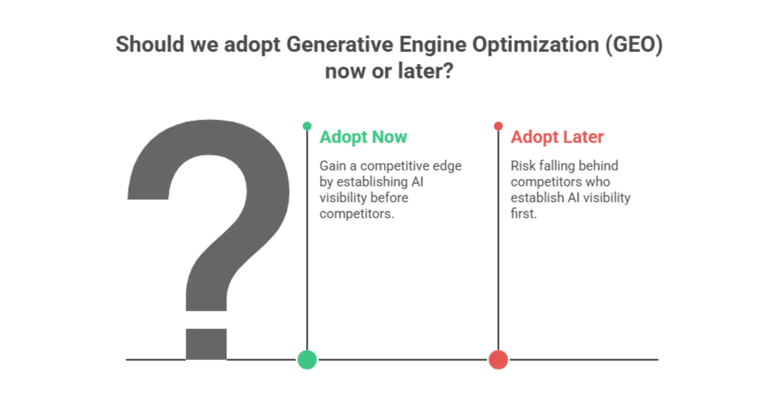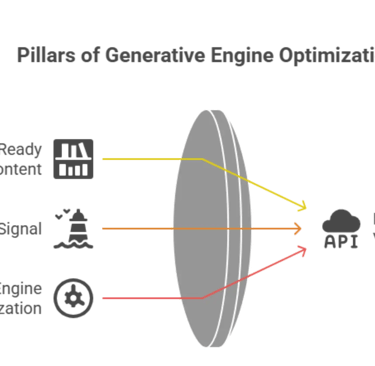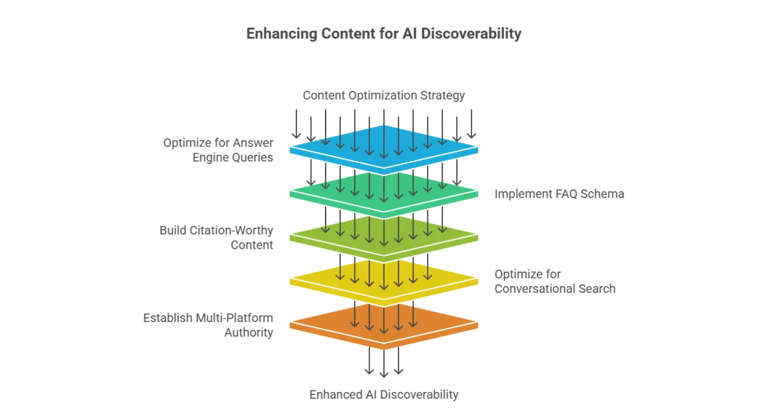GEO vs SEO: Why Ranking on Google Isn't Enough in 2025
AI_SEOSAASGROWTH
7/24/20256 min read


Traditional SEO focuses on ranking in search engine results pages (SERPs). Generative Engine Optimization (GEO) focuses on ranking in AI-generated responses. The difference isn't just technical—it's strategic.
Gartner predicts a 25% drop in search volumes due to AI chatbots by 2026, while 42% of users now prefer ChatGPT over Google for specific types of queries. When prospects ask "What's the best marketing automation platform?" ChatGPT synthesizes answers from multiple sources—but will your brand be mentioned?
This isn't a distant future scenario. Right now, AI engines are shaping purchase decisions in B2B markets. Companies optimizing only for traditional search are missing conversations where buying decisions happen. The question isn't whether to adopt GEO—it's whether to start before or after competitors establish AI visibility dominance.


This isn't a distant future scenario. Right now, AI engines are shaping purchase decisions in B2B markets. Companies optimizing only for traditional search are missing conversations where buying decisions happen. The question isn't whether to adopt GEO—it's whether to start before or after competitors establish AI visibility dominance.


The Great Search Disruption: From Links to Conversations
Traditional search engines return lists of links. Generative engines synthesize information from multiple sources to create comprehensive, conversational responses. This isn't just a new feature—it's a completely different way users discover and consume information.
The numbers tell the story:
Perplexity AI reached 22 million active users in the first half of 2025, with revenue growing 600% to $35 million
ChatGPT search traffic grew 44% and is now 6x larger than Perplexity
Perplexity attracts 152.5 million unique monthly visitors driven by organic search
But here's what most marketers miss: Even when AI engines cite sources, they're not necessarily driving traffic. Users often get their answers directly from the AI response, never clicking through to your website. The traditional funnel of search → click → convert is being compressed into search → answer → decision.
This creates a new challenge: How do you build brand authority and capture demand when your content is consumed but not visited?
The Generative Visibility Framework: Beyond Traditional SEO
The solution isn't to abandon SEO—it's to expand beyond it. At Briskfab, we've developed what we call the Generative Visibility Framework, a systematic approach to ensuring your content ranks in both traditional search and AI-generated responses.
The Three Pillars of Generative Visibility
1. Citation-Ready Content Architecture Traditional SEO optimizes for keyword rankings. Generative Engine Optimization (GEO) optimizes for AI citations. Your content needs to be structured so AI engines can easily extract, understand, and reference specific insights.
2. Authority Signal Amplification AI engines prioritize authoritative sources. But authority in the AI era isn't just about backlinks—it's about consistent, expert-level information across multiple touchpoints that AI can validate and cross-reference.
3. Multi-Engine Optimization Each AI platform has different preferences. ChatGPT might favor conversational, detailed explanations. Perplexity prioritizes sources with clear citations and data. Google's AI Overviews pull from their traditional search index but emphasize fresh, comprehensive content.


The Great Search Disruption: From Links to Conversations
Traditional search engines return lists of links. Generative engines synthesize information from multiple sources to create comprehensive, conversational responses. This isn't just a new feature—it's a completely different way users discover and consume information.
The numbers tell the story:
Perplexity AI reached 22 million active users in the first half of 2025, with revenue growing 600% to $35 million
ChatGPT search traffic grew 44% and is now 6x larger than Perplexity
Perplexity attracts 152.5 million unique monthly visitors driven by organic search
But here's what most marketers miss: Even when AI engines cite sources, they're not necessarily driving traffic. Users often get their answers directly from the AI response, never clicking through to your website. The traditional funnel of search → click → convert is being compressed into search → answer → decision.
This creates a new challenge: How do you build brand authority and capture demand when your content is consumed but not visited?
The Generative Visibility Framework: Beyond Traditional SEO
The solution isn't to abandon SEO—it's to expand beyond it. At Briskfab, we've developed what we call the Generative Visibility Framework, a systematic approach to ensuring your content ranks in both traditional search and AI-generated responses.
The Three Pillars of Generative Visibility
1. Citation-Ready Content Architecture Traditional SEO optimizes for keyword rankings. Generative Engine Optimization (GEO) optimizes for AI citations. Your content needs to be structured so AI engines can easily extract, understand, and reference specific insights.
2. Authority Signal Amplification AI engines prioritize authoritative sources. But authority in the AI era isn't just about backlinks—it's about consistent, expert-level information across multiple touchpoints that AI can validate and cross-reference.
3. Multi-Engine Optimization Each AI platform has different preferences. ChatGPT might favor conversational, detailed explanations. Perplexity prioritizes sources with clear citations and data. Google's AI Overviews pull from their traditional search index but emphasize fresh, comprehensive content.


Case Study: B2B SaaS Company Achieves 40% AI Visibility Increase
A B2B marketing automation platform worked with Briskfab to implement the Generative Visibility Framework. The results after six months:
40% increase in AI engine citations across ChatGPT, Perplexity, and Google AI Overviews
25% boost in branded search volume as AI responses increased brand awareness
15% improvement in organic traffic quality as AI-discovered users showed higher intent
The strategy: They restructured their comparison pages to include clear, fact-based sections that AI could easily extract. They added comprehensive FAQ sections addressing common buyer questions. Most importantly, they created original research reports that became go-to citations for AI engines discussing marketing automation trends.
Key insight: The traffic didn't just shift—it compounded. AI citations drove brand awareness, which increased branded searches, which improved traditional SEO performance.
The Future of Search: Authority Over Algorithms
The era of gaming search algorithms is ending. The future belongs to brands that build genuine authority and provide authentic value. AI engines are sophisticated enough to distinguish between content created for algorithms and content created for humans.
This shift represents both a challenge and an opportunity. Companies that adapt early will establish themselves as authoritative voices in their industries. Those that don't risk becoming invisible as search behavior evolves.
The strategic imperative is clear: Build content that serves both human readers and AI engines. Focus on expertise, authority, and trustworthiness—not just keyword density and backlink counts.
At Briskfab, we help B2B SaaS, fintech, and edtech companies navigate this transition. Our AI SEO approach combines traditional search optimization with generative engine strategies, ensuring your content remains discoverable regardless of how search evolves.
The question isn't whether AI will reshape search—it's whether your content strategy will evolve fast enough to stay visible. The companies that master generative visibility today will dominate tomorrow's search landscape.
Frequently Asked Questions
What's the difference between SEO and GEO?
SEO optimizes content to rank in traditional search engine results pages (SERPs) like Google. GEO optimizes content to appear in AI-generated responses from tools like ChatGPT, Perplexity, and Google's AI Overviews. While SEO focuses on driving clicks to your website, GEO focuses on getting cited as an authoritative source in AI responses.
Can GEO and SEO work together?
Absolutely. The most effective approach combines both strategies. Traditional SEO still drives significant traffic and builds domain authority, while GEO ensures visibility in AI-generated responses. Many ranking factors overlap—high-quality content, topical authority, and structured data benefit both traditional and AI search.
How do you measure GEO success?
Unlike traditional SEO metrics (rankings, clicks, impressions), GEO success is measured through citation tracking, brand mention analysis, and AI visibility monitoring. Tools like HubSpot's AI Search Grader help track brand presence in AI-generated responses. Key metrics include citation frequency, source attribution, and brand sentiment in AI responses.
What types of content perform best for GEO?
AI engines favor content that's structured, authoritative, and citation-ready. This includes comprehensive guides, original research, comparison tables, FAQ sections, and content with clear statistics and data points. The key is creating content that AI can easily extract and reference.
How long does it take to see GEO results?
GEO results can appear faster than traditional SEO because AI engines don't rely on the same crawling and indexing processes. High-quality, well-structured content can be cited by AI engines within weeks. However, building consistent authority across multiple AI platforms typically takes 3-6 months.
Do you need different content for different AI engines?
While core content quality principles apply across all AI engines, different platforms have preferences. ChatGPT favors conversational, detailed explanations. Perplexity prioritizes sources with clear citations. Google's AI Overviews pull from their search index but emphasize fresh, comprehensive content. The key is understanding each platform's preferences while maintaining content quality.
How is Briskfab implementing GEO strategies?
At Briskfab, we practice what we preach. This blog post itself demonstrates GEO principles—it includes structured headings, FAQ schema, clear citations, and comprehensive coverage of the topic. We've optimized our content architecture to be citation-ready, built topical authority through consistent publishing, and structured information to support AI understanding. Our approach combines traditional SEO foundations with AI-first optimization strategies.
